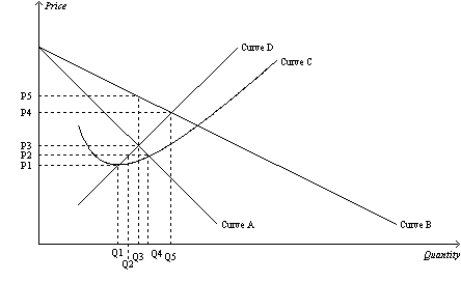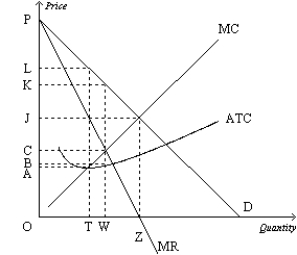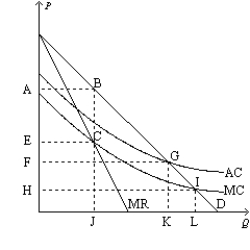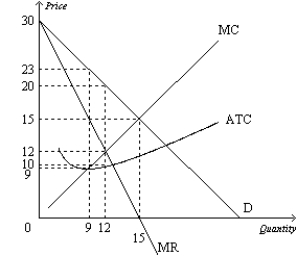A) (B-F) *K
B) 0.5[(P-O) *(L-O) ]
C) 0.5[(A-H) *(L-J) ]
D) 0.5[(B-F) *(L-K) ]
F) A) and C)
Correct Answer

verified
Correct Answer
verified
Multiple Choice
Generic drugs enter the pharmaceutical drug market once
A) the ingredients to the name brand drug have been discovered.
B) 10 years have passed.
C) they are patented.
D) the patent on the name brand drug expires.
F) A) and B)
Correct Answer

verified
Correct Answer
verified
Multiple Choice
A perfectly competitive firm produces where
A) marginal cost equals price, while a monopolist produces where price exceeds marginal cost.
B) marginal cost equals price, while a monopolist produces where marginal cost exceeds price.
C) price exceeds marginal cost, while a monopolist produces where marginal cost equals price.
D) marginal cost exceeds price, while a monopolist produces where marginal cost equals price.
F) A) and C)
Correct Answer

verified
Correct Answer
verified
Multiple Choice
Scenario 15-10
Vincent operates a scenic tour business in Boston. He has one bus which can fit 50 people per tour and each tour lasts 2 hours. His total cost of operating one tour is fixed at $450. Vincent's cost is not reduced if he runs a tour with a partially full bus. While his cost is the same for all tours, Vincent charges each passenger his/her willingness to pay: adults $18 per trip, children $10 per trip, and senior citizens $12 per trip. At those rates, on a typical day Vincent's demand is:
 Assume that Vincent's customers are always available for the tour; therefore, he can fill his bus for each tour as long as there is sufficient total demand for the day.
-Refer to Scenario 15-10. What is Vincent's profit on a typical day?
Assume that Vincent's customers are always available for the tour; therefore, he can fill his bus for each tour as long as there is sufficient total demand for the day.
-Refer to Scenario 15-10. What is Vincent's profit on a typical day?
A) $660
B) $820
C) $1,350
D) $2,170
F) A) and C)
Correct Answer

verified
Correct Answer
verified
Multiple Choice
A market structure with barriers to entry is
A) a monopoly.
B) oligopolistically competitive.
C) monopolistically competitive.
D) perfectly competitive.
F) A) and D)
Correct Answer

verified
Correct Answer
verified
Multiple Choice
"Monopolists do not worry about efficient production and minimizing costs since they can just pass along any increase in costs to their consumers." This statement is
A) false; price increases will mean fewer sales, which may lower profits.
B) true; this is the primary reason why economists believe that monopolies result in economic inefficiency.
C) false; the monopolist is a price taker.
D) true; consumers in a monopoly market have no substitutes to turn to when the monopolist raises prices.
F) A) and C)
Correct Answer

verified
Correct Answer
verified
Multiple Choice
Table 15-19
A monopolist faces the following demand curve:
 -Refer to Table 15-19. If a monopolist faces a constant marginal cost of $3, how much output should the firm produce?
-Refer to Table 15-19. If a monopolist faces a constant marginal cost of $3, how much output should the firm produce?
A) 3 units
B) 4 units
C) 5 units
D) 6 units
F) A) and B)
Correct Answer

verified
Correct Answer
verified
True/False
Deadweight loss measures the loss in society's welfare that occurs because a monopolist does not produce the socially efficient level of output.
B) False
Correct Answer

verified
Correct Answer
verified
Multiple Choice
Figure 15-4  -Refer to Figure 15-4. A profit-maximizing monopoly's total revenue is equal to
-Refer to Figure 15-4. A profit-maximizing monopoly's total revenue is equal to
A) P5 x Q3.
B) P4 x Q5.
C) (P5-P3) x Q3.
D) (P5-P4) x Q3.
F) All of the above
Correct Answer

verified
Correct Answer
verified
Multiple Choice
Figure 15-6  -Refer to Figure 15-6. What price will the monopolist charge?
-Refer to Figure 15-6. What price will the monopolist charge?
A) A
B) C
C) K
D) L
F) C) and D)
Correct Answer

verified
Correct Answer
verified
True/False
Firms with substantial monopoly power are quite common because many goods are unique.
B) False
Correct Answer

verified
Correct Answer
verified
Short Answer
Figure 15-25  -Refer to Figure 15-25. If a regulator requires this firm to charge a socially optimal price, how much deadweight loss results?
-Refer to Figure 15-25. If a regulator requires this firm to charge a socially optimal price, how much deadweight loss results?
Correct Answer

verified
Correct Answer
verified
Multiple Choice
The laws governing patents and copyrights
A) promote monopolies.
B) are intended to serve private interests, not the public's interest.
C) have costs but not benefits.
D) eliminate the need for firms to engage in research and development.
F) A) and D)
Correct Answer

verified
Correct Answer
verified
Multiple Choice
Table 15-20
A monopolist faces the following demand curve:
 -Refer to Table 15-20. If a monopolist faces a constant marginal cost of $5, how much output should the firm produce in order to maximize profit?
-Refer to Table 15-20. If a monopolist faces a constant marginal cost of $5, how much output should the firm produce in order to maximize profit?
A) 2 units
B) 3 units
C) 4 units
D) 5 units
F) A) and C)
Correct Answer

verified
Correct Answer
verified
Multiple Choice
Figure 15-7  -Refer to Figure 15-7. In order to maximize profits, the monopolist should produce
-Refer to Figure 15-7. In order to maximize profits, the monopolist should produce
A) 9 units.
B) 12 units.
C) 15 units.
D) more than 15 units.
F) B) and C)
Correct Answer

verified
Correct Answer
verified
True/False
One characteristic of a monopoly market is that the product is virtually identical to products produced by competing firms.
B) False
Correct Answer

verified
Correct Answer
verified
Multiple Choice
If a monopolist sells 100 units at $8 per unit and realizes an average total cost of $6 per unit, what is the monopolist's profit?
A) $200
B) $400
C) $600
D) $800
F) C) and D)
Correct Answer

verified
Correct Answer
verified
Multiple Choice
Figure 15-4  -Refer to Figure 15-4. If the monopoly firm is currently producing Q3 units of output, then a decrease in output will necessarily cause profit to
-Refer to Figure 15-4. If the monopoly firm is currently producing Q3 units of output, then a decrease in output will necessarily cause profit to
A) remain unchanged.
B) decrease.
C) increase as long as the new level of output is at least Q2.
D) increase as long as the new level of output is at least Q1.
F) B) and C)
Correct Answer

verified
Correct Answer
verified
Multiple Choice
Table 15-6
A monopolist faces the following demand curve:
 -Refer to Table 15-6. What is the marginal revenue from the sale of the 4th unit?
-Refer to Table 15-6. What is the marginal revenue from the sale of the 4th unit?
A) $3
B) -$3
C) $9
D) $24
F) A) and B)
Correct Answer

verified
Correct Answer
verified
Multiple Choice
Which of the following statements is correct?
A) The benefits that accrue to a monopoly's owners are equal to the costs that are incurred by consumers of that firm's product.
B) The deadweight loss that arises in monopoly stems from the fact that the profit-maximizing monopoly firm produces a quantity of output that exceeds the socially-efficient quantity.
C) The deadweight loss caused by monopoly is similar to the deadweight loss caused by a tax on a product.
D) The primary social problem caused by monopoly is monopoly profit.
F) A) and C)
Correct Answer

verified
Correct Answer
verified
Showing 401 - 420 of 637
Related Exams